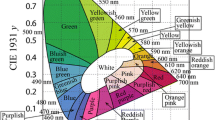It has been shown experimentally that light sources can be produced from commercial blue LEDs and two narrow-band nanocrystalline phosphors (CsPbBr3 and CdSe/CdZnS) that simultaneously satisfy the following criteria: the emission spectrum maximum corresponds to the peak of human vision sensitivity at night (505 nm); the color coordinates in the CIE 1931 standard are close to the point [0.33; 0.33]; the correlated color temperature CCT ~ 6000 K with the possibility of moving to warmer light with CCT ~ 4500 K; and the full range of possible colors (gamut) exceeds the norms of the HDTV standard, approaching the UHDTV standard. It is noted that for serious progress in the development of lighting sources adapted to human night and twilight vision, metrological standards and corrected units of brightness and luminous intensity must be developed while refusing to use the color rendering index for night and twilight lighting.
Similar content being viewed by others
References
S. V. Gaponenko and H. V. Demir, Applied Nanophotonics, Cambridge University Press, Cambridge UK (2018), pp. 229–265.
G. Li, Y. Tian, Y. Zhao, and J. Lin, Chem. Soc. Rev., 44, 8688–8713 (2015).
C. C. Lin, A. Meijerink, and R. S. Liu, J. Phys. Chem. Lett., 7, 495–503 (2016).
J. Li, J. Yan, D. Wen, W. U. Khan, J. Shi, M. Wu, Q. Su, and P. A. Tanner, J. Mater. Chem. C, 4, 8611–8623 (2016).
T. Erdem and H. V. Demir, Nanophotonics, 5, No. 1, 74–95 (2016).
Y. E. Panfil, M. Oded, and U. Banin, Angew. Chem. Int. Ed., 57, No. 16, 4274–4295 (2018).
M. Bidikoudi, E. Fresta, and R. D. Costa, Chem. Commun., 54, No. 59, 8150–8169 (2018).
Z. He, C. Zhang, Y. Dong, and S. T. Wu, Crystals, 9, No. 2, 59 (2019).
T. Guner and M. M. Demir, Phys. Status Solidi A, 215, No. 13, Article ID 1800120 (2018).
F. Yan, S. T. Tan, X. Li, and H. V. Demir, Small, 15, No. 47, Article ID 1902079 (2019).
http://files.cie.co.at/841_CIE_TN_004-2016.pdf, accessed October 4, 2022.
https://cie-group.com/how-to-av/videos-and-blogs/bio-adaptive-lighting, accessed Oct. 4, 2022.
S. V. Gaponenko, H. V. Demir, C. Seassal, and U. Woggon, Opt. Express, 24, No. 2, A430–A433 (2016).
L. L. Trotsiuk, E. S. Ton, V. I. Tsvirka, L. N. Survilo, S. I. Lishik, O. S. Kulakovich, A. A. Ramanenka, V. V. Krukov, Yu. V. Trofimov, and S. V. Gaponenko, J. Appl. Spectrosc., 89, 869–873 (2022).
L. Protesescu, S. Yakunin, M. I. Bodnarchuk, F. Krieg, R. Caputo, C. H. Hendon, R. X. Yang, A. Walsh, and M. V. Kovalenko, Nano Lett., 15, No. 6, 3692–3696 (2015).
https://www.osram.us/cb/tools-and-resources/applications/led-colorcalculator/index.jsp, accessed October 18, 2022.
C. S. McCamy, Color Res. Appl., 17, No. 2, 142–144 (1992) and erratum, Color Res. Appl., 18, 150 (1993).
J.-S. B. Valencia, F.-E. L. Giraldo, and J.-F. V. Bonilla, Calibration Method for Correlated Color Temperature (CCT) Measurement Using RGB Color Sensors, Symposium of Signals, Images and Artificial Vision (STSIVA), September 11–13, 2013, Bogota, Colombia, Proc. IEEE, 1–6 (2013).
ITU-R, Recommendation BT.709-6, Parameter Values for the HDTV Standards for Production and International Programme Exchange, International Telecommunication Union, Geneva, June 2015 (2015).
Recommendation ITU-R BT.2020-1 Parameter Values for Ultra-high Definition Television Systems for Production and International Programme Exchange, International Telecommunication Union, Geneva, June 2014 (2014).
S. V. Gaponenko and D. V. Guzatov, Proc. IEEE, 108, No. 5, 704–720 (2020).
Author information
Authors and Affiliations
Corresponding author
Additional information
Translated from Zhurnal Prikladnoi Spektroskopii, Vol. 90, No. 1, pp. 61–66, January–February, 2023.https://doi.org/10.47612/0514-7506-2023-90-1-61-66.
Rights and permissions
Springer Nature or its licensor (e.g. a society or other partner) holds exclusive rights to this article under a publishing agreement with the author(s) or other rightsholder(s); author self-archiving of the accepted manuscript version of this article is solely governed by the terms of such publishing agreement and applicable law.
About this article
Cite this article
Patsinko, O.I., Ramanenka, A.A., Krukov, V.V. et al. Phosphor Based on CsPbBr3 and CdSe/CdZnS Nanocrystals Adapted to Human Twilight Vision. J Appl Spectrosc 90, 54–59 (2023). https://doi.org/10.1007/s10812-023-01502-0
Received:
Published:
Issue Date:
DOI: https://doi.org/10.1007/s10812-023-01502-0



